Leadership and Management: Answering Leadership Questions
VerifiedAdded on 2020/04/15
|9
|2403
|52
Homework Assignment
AI Summary
This assignment delves into various aspects of leadership and management, providing answers to key questions. It explores strategies for improving organizational communication, highlighting the importance of open environments, inclusive practices, and effective channels. The assignment contrasts the roles of leaders and managers, differentiating their approaches to vision creation, goal setting, innovation, and risk management. It examines the critical role of leaders during organizational change, emphasizing their responsibilities as sponsors, role models, resource managers, communicators, and motivators. The concept of servant leadership is also discussed, emphasizing its focus on serving employees and fostering their development. Different leadership styles, including autocratic, democratic, transformational, cross-cultural, laissez-faire, and transactional, are defined and compared. The features of bureaucracy, such as division of labor, hierarchical authority, rules and regulations, impersonality, and competence, are also analyzed. Finally, the assignment touches upon Maslow's hierarchy of needs, a motivational theory that outlines the stages of human needs that must be fulfilled for individual motivation. This comprehensive analysis provides a thorough understanding of leadership and management principles.
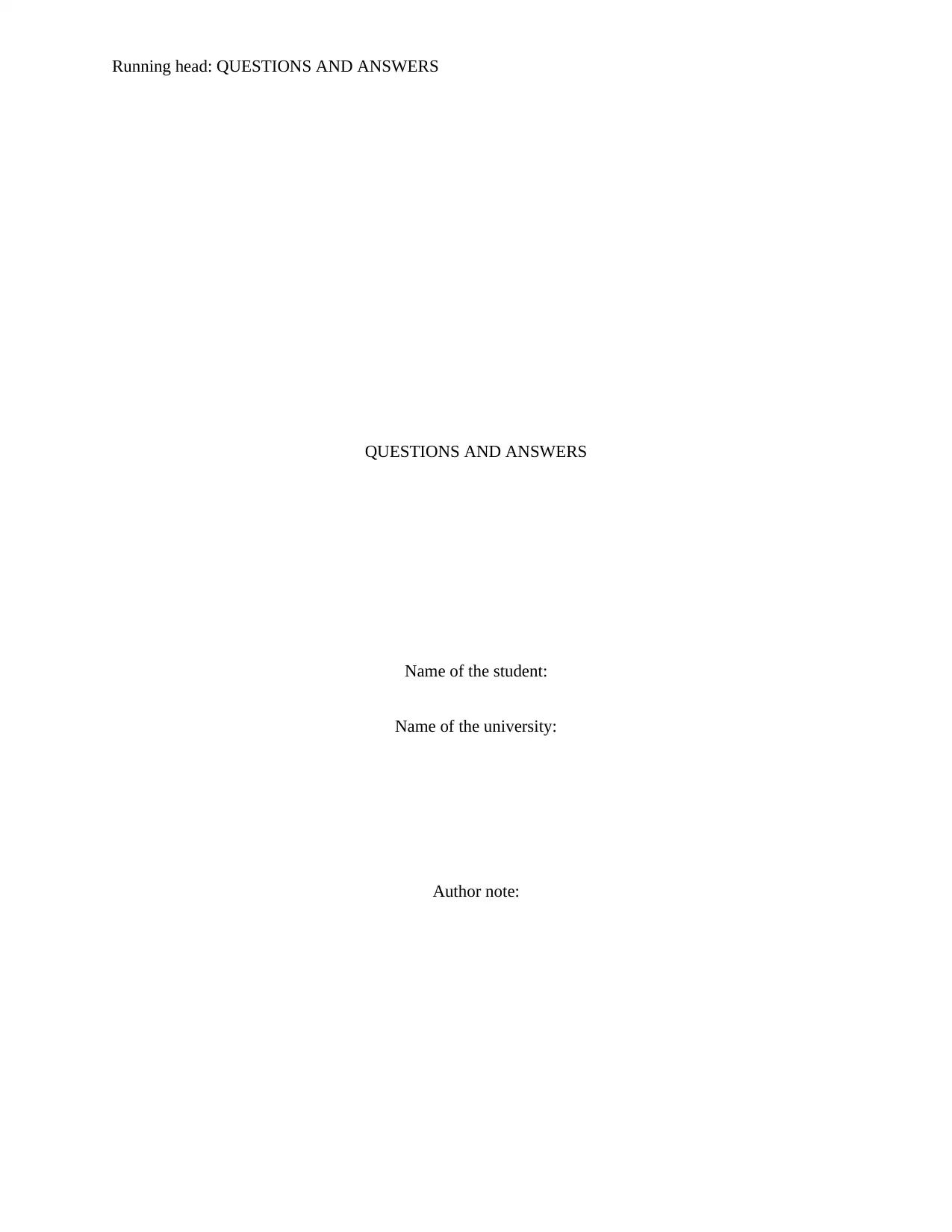
Running head: QUESTIONS AND ANSWERS
QUESTIONS AND ANSWERS
Name of the student:
Name of the university:
Author note:
QUESTIONS AND ANSWERS
Name of the student:
Name of the university:
Author note:
Paraphrase This Document
Need a fresh take? Get an instant paraphrase of this document with our AI Paraphraser
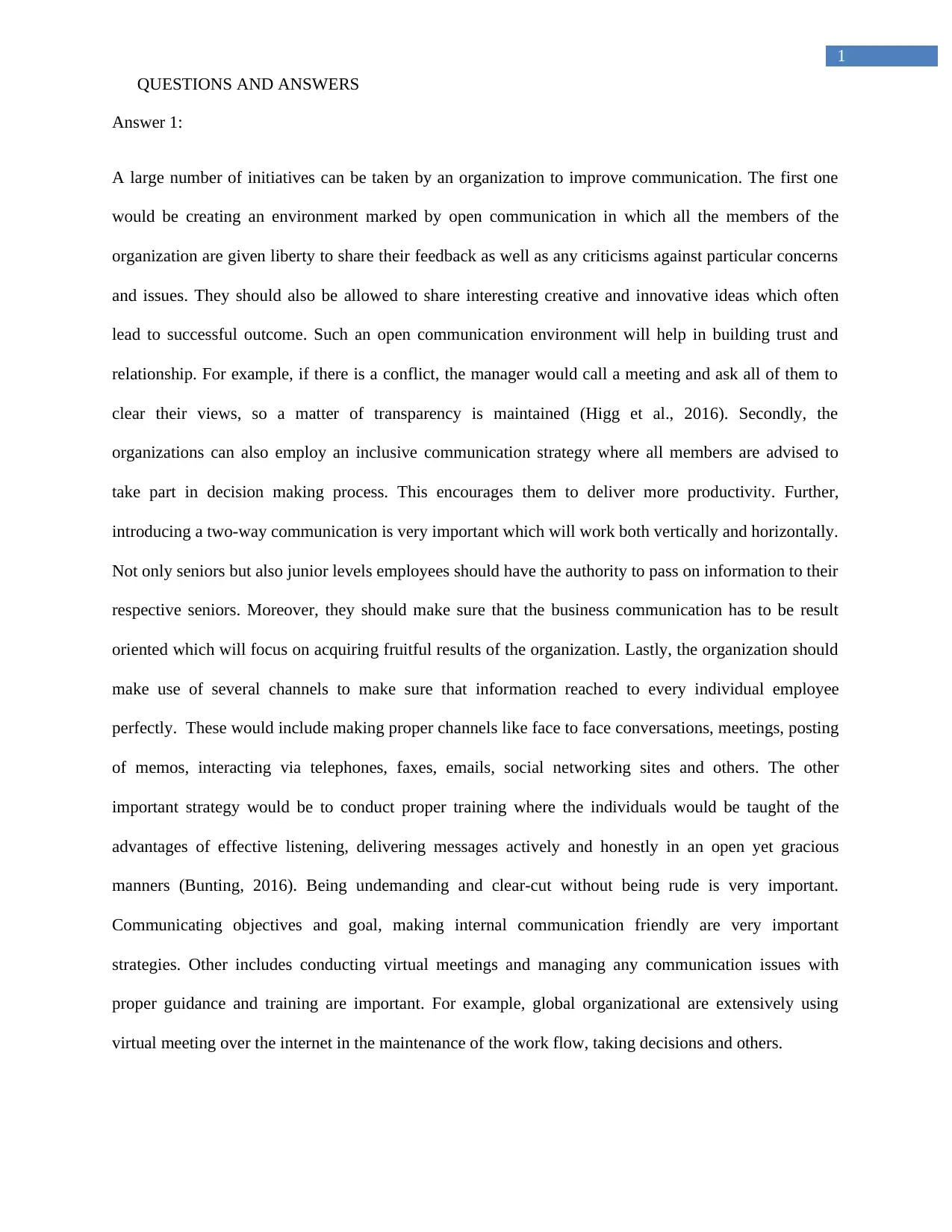
1
QUESTIONS AND ANSWERS
Answer 1:
A large number of initiatives can be taken by an organization to improve communication. The first one
would be creating an environment marked by open communication in which all the members of the
organization are given liberty to share their feedback as well as any criticisms against particular concerns
and issues. They should also be allowed to share interesting creative and innovative ideas which often
lead to successful outcome. Such an open communication environment will help in building trust and
relationship. For example, if there is a conflict, the manager would call a meeting and ask all of them to
clear their views, so a matter of transparency is maintained (Higg et al., 2016). Secondly, the
organizations can also employ an inclusive communication strategy where all members are advised to
take part in decision making process. This encourages them to deliver more productivity. Further,
introducing a two-way communication is very important which will work both vertically and horizontally.
Not only seniors but also junior levels employees should have the authority to pass on information to their
respective seniors. Moreover, they should make sure that the business communication has to be result
oriented which will focus on acquiring fruitful results of the organization. Lastly, the organization should
make use of several channels to make sure that information reached to every individual employee
perfectly. These would include making proper channels like face to face conversations, meetings, posting
of memos, interacting via telephones, faxes, emails, social networking sites and others. The other
important strategy would be to conduct proper training where the individuals would be taught of the
advantages of effective listening, delivering messages actively and honestly in an open yet gracious
manners (Bunting, 2016). Being undemanding and clear-cut without being rude is very important.
Communicating objectives and goal, making internal communication friendly are very important
strategies. Other includes conducting virtual meetings and managing any communication issues with
proper guidance and training are important. For example, global organizational are extensively using
virtual meeting over the internet in the maintenance of the work flow, taking decisions and others.
QUESTIONS AND ANSWERS
Answer 1:
A large number of initiatives can be taken by an organization to improve communication. The first one
would be creating an environment marked by open communication in which all the members of the
organization are given liberty to share their feedback as well as any criticisms against particular concerns
and issues. They should also be allowed to share interesting creative and innovative ideas which often
lead to successful outcome. Such an open communication environment will help in building trust and
relationship. For example, if there is a conflict, the manager would call a meeting and ask all of them to
clear their views, so a matter of transparency is maintained (Higg et al., 2016). Secondly, the
organizations can also employ an inclusive communication strategy where all members are advised to
take part in decision making process. This encourages them to deliver more productivity. Further,
introducing a two-way communication is very important which will work both vertically and horizontally.
Not only seniors but also junior levels employees should have the authority to pass on information to their
respective seniors. Moreover, they should make sure that the business communication has to be result
oriented which will focus on acquiring fruitful results of the organization. Lastly, the organization should
make use of several channels to make sure that information reached to every individual employee
perfectly. These would include making proper channels like face to face conversations, meetings, posting
of memos, interacting via telephones, faxes, emails, social networking sites and others. The other
important strategy would be to conduct proper training where the individuals would be taught of the
advantages of effective listening, delivering messages actively and honestly in an open yet gracious
manners (Bunting, 2016). Being undemanding and clear-cut without being rude is very important.
Communicating objectives and goal, making internal communication friendly are very important
strategies. Other includes conducting virtual meetings and managing any communication issues with
proper guidance and training are important. For example, global organizational are extensively using
virtual meeting over the internet in the maintenance of the work flow, taking decisions and others.
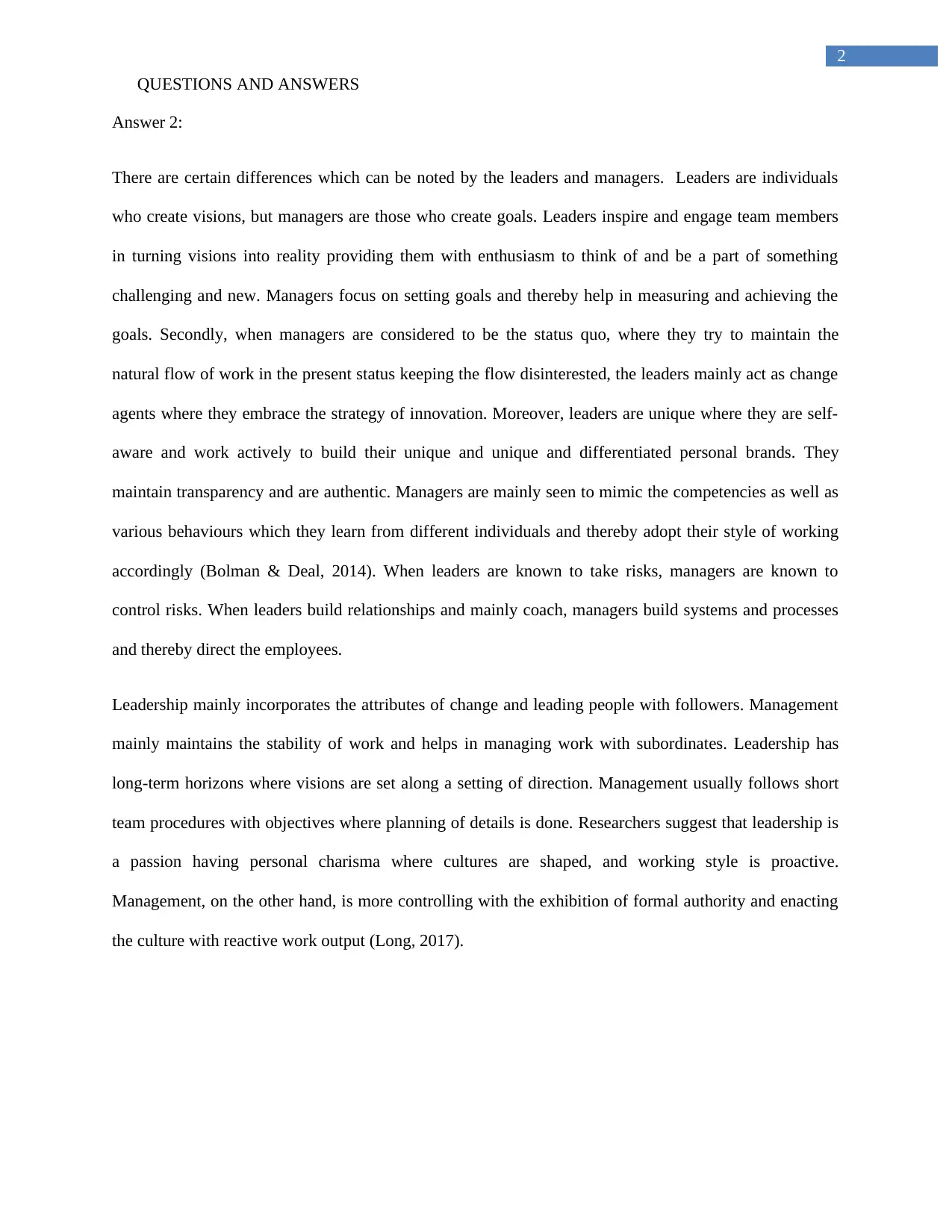
2
QUESTIONS AND ANSWERS
Answer 2:
There are certain differences which can be noted by the leaders and managers. Leaders are individuals
who create visions, but managers are those who create goals. Leaders inspire and engage team members
in turning visions into reality providing them with enthusiasm to think of and be a part of something
challenging and new. Managers focus on setting goals and thereby help in measuring and achieving the
goals. Secondly, when managers are considered to be the status quo, where they try to maintain the
natural flow of work in the present status keeping the flow disinterested, the leaders mainly act as change
agents where they embrace the strategy of innovation. Moreover, leaders are unique where they are self-
aware and work actively to build their unique and unique and differentiated personal brands. They
maintain transparency and are authentic. Managers are mainly seen to mimic the competencies as well as
various behaviours which they learn from different individuals and thereby adopt their style of working
accordingly (Bolman & Deal, 2014). When leaders are known to take risks, managers are known to
control risks. When leaders build relationships and mainly coach, managers build systems and processes
and thereby direct the employees.
Leadership mainly incorporates the attributes of change and leading people with followers. Management
mainly maintains the stability of work and helps in managing work with subordinates. Leadership has
long-term horizons where visions are set along a setting of direction. Management usually follows short
team procedures with objectives where planning of details is done. Researchers suggest that leadership is
a passion having personal charisma where cultures are shaped, and working style is proactive.
Management, on the other hand, is more controlling with the exhibition of formal authority and enacting
the culture with reactive work output (Long, 2017).
QUESTIONS AND ANSWERS
Answer 2:
There are certain differences which can be noted by the leaders and managers. Leaders are individuals
who create visions, but managers are those who create goals. Leaders inspire and engage team members
in turning visions into reality providing them with enthusiasm to think of and be a part of something
challenging and new. Managers focus on setting goals and thereby help in measuring and achieving the
goals. Secondly, when managers are considered to be the status quo, where they try to maintain the
natural flow of work in the present status keeping the flow disinterested, the leaders mainly act as change
agents where they embrace the strategy of innovation. Moreover, leaders are unique where they are self-
aware and work actively to build their unique and unique and differentiated personal brands. They
maintain transparency and are authentic. Managers are mainly seen to mimic the competencies as well as
various behaviours which they learn from different individuals and thereby adopt their style of working
accordingly (Bolman & Deal, 2014). When leaders are known to take risks, managers are known to
control risks. When leaders build relationships and mainly coach, managers build systems and processes
and thereby direct the employees.
Leadership mainly incorporates the attributes of change and leading people with followers. Management
mainly maintains the stability of work and helps in managing work with subordinates. Leadership has
long-term horizons where visions are set along a setting of direction. Management usually follows short
team procedures with objectives where planning of details is done. Researchers suggest that leadership is
a passion having personal charisma where cultures are shaped, and working style is proactive.
Management, on the other hand, is more controlling with the exhibition of formal authority and enacting
the culture with reactive work output (Long, 2017).
⊘ This is a preview!⊘
Do you want full access?
Subscribe today to unlock all pages.

Trusted by 1+ million students worldwide
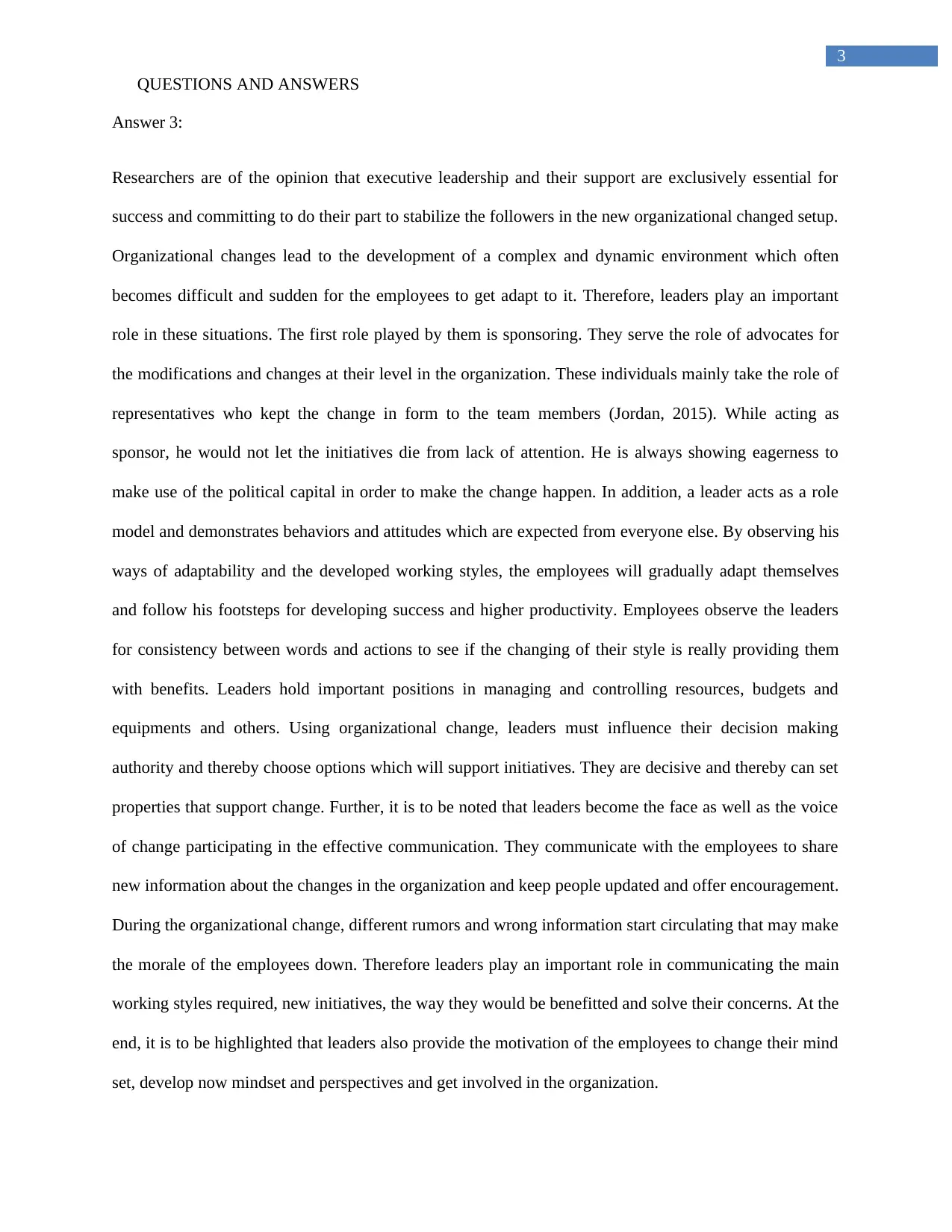
3
QUESTIONS AND ANSWERS
Answer 3:
Researchers are of the opinion that executive leadership and their support are exclusively essential for
success and committing to do their part to stabilize the followers in the new organizational changed setup.
Organizational changes lead to the development of a complex and dynamic environment which often
becomes difficult and sudden for the employees to get adapt to it. Therefore, leaders play an important
role in these situations. The first role played by them is sponsoring. They serve the role of advocates for
the modifications and changes at their level in the organization. These individuals mainly take the role of
representatives who kept the change in form to the team members (Jordan, 2015). While acting as
sponsor, he would not let the initiatives die from lack of attention. He is always showing eagerness to
make use of the political capital in order to make the change happen. In addition, a leader acts as a role
model and demonstrates behaviors and attitudes which are expected from everyone else. By observing his
ways of adaptability and the developed working styles, the employees will gradually adapt themselves
and follow his footsteps for developing success and higher productivity. Employees observe the leaders
for consistency between words and actions to see if the changing of their style is really providing them
with benefits. Leaders hold important positions in managing and controlling resources, budgets and
equipments and others. Using organizational change, leaders must influence their decision making
authority and thereby choose options which will support initiatives. They are decisive and thereby can set
properties that support change. Further, it is to be noted that leaders become the face as well as the voice
of change participating in the effective communication. They communicate with the employees to share
new information about the changes in the organization and keep people updated and offer encouragement.
During the organizational change, different rumors and wrong information start circulating that may make
the morale of the employees down. Therefore leaders play an important role in communicating the main
working styles required, new initiatives, the way they would be benefitted and solve their concerns. At the
end, it is to be highlighted that leaders also provide the motivation of the employees to change their mind
set, develop now mindset and perspectives and get involved in the organization.
QUESTIONS AND ANSWERS
Answer 3:
Researchers are of the opinion that executive leadership and their support are exclusively essential for
success and committing to do their part to stabilize the followers in the new organizational changed setup.
Organizational changes lead to the development of a complex and dynamic environment which often
becomes difficult and sudden for the employees to get adapt to it. Therefore, leaders play an important
role in these situations. The first role played by them is sponsoring. They serve the role of advocates for
the modifications and changes at their level in the organization. These individuals mainly take the role of
representatives who kept the change in form to the team members (Jordan, 2015). While acting as
sponsor, he would not let the initiatives die from lack of attention. He is always showing eagerness to
make use of the political capital in order to make the change happen. In addition, a leader acts as a role
model and demonstrates behaviors and attitudes which are expected from everyone else. By observing his
ways of adaptability and the developed working styles, the employees will gradually adapt themselves
and follow his footsteps for developing success and higher productivity. Employees observe the leaders
for consistency between words and actions to see if the changing of their style is really providing them
with benefits. Leaders hold important positions in managing and controlling resources, budgets and
equipments and others. Using organizational change, leaders must influence their decision making
authority and thereby choose options which will support initiatives. They are decisive and thereby can set
properties that support change. Further, it is to be noted that leaders become the face as well as the voice
of change participating in the effective communication. They communicate with the employees to share
new information about the changes in the organization and keep people updated and offer encouragement.
During the organizational change, different rumors and wrong information start circulating that may make
the morale of the employees down. Therefore leaders play an important role in communicating the main
working styles required, new initiatives, the way they would be benefitted and solve their concerns. At the
end, it is to be highlighted that leaders also provide the motivation of the employees to change their mind
set, develop now mindset and perspectives and get involved in the organization.
Paraphrase This Document
Need a fresh take? Get an instant paraphrase of this document with our AI Paraphraser
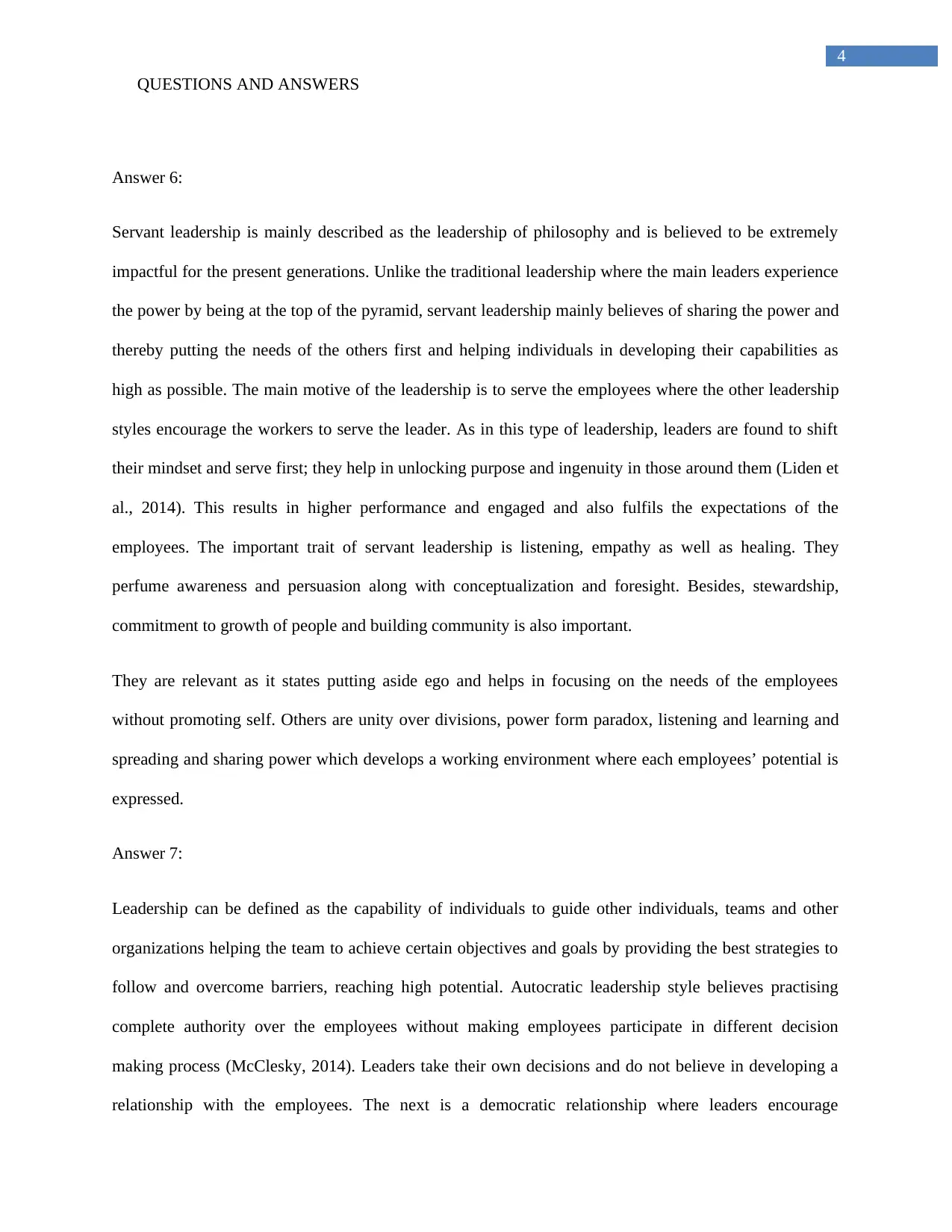
4
QUESTIONS AND ANSWERS
Answer 6:
Servant leadership is mainly described as the leadership of philosophy and is believed to be extremely
impactful for the present generations. Unlike the traditional leadership where the main leaders experience
the power by being at the top of the pyramid, servant leadership mainly believes of sharing the power and
thereby putting the needs of the others first and helping individuals in developing their capabilities as
high as possible. The main motive of the leadership is to serve the employees where the other leadership
styles encourage the workers to serve the leader. As in this type of leadership, leaders are found to shift
their mindset and serve first; they help in unlocking purpose and ingenuity in those around them (Liden et
al., 2014). This results in higher performance and engaged and also fulfils the expectations of the
employees. The important trait of servant leadership is listening, empathy as well as healing. They
perfume awareness and persuasion along with conceptualization and foresight. Besides, stewardship,
commitment to growth of people and building community is also important.
They are relevant as it states putting aside ego and helps in focusing on the needs of the employees
without promoting self. Others are unity over divisions, power form paradox, listening and learning and
spreading and sharing power which develops a working environment where each employees’ potential is
expressed.
Answer 7:
Leadership can be defined as the capability of individuals to guide other individuals, teams and other
organizations helping the team to achieve certain objectives and goals by providing the best strategies to
follow and overcome barriers, reaching high potential. Autocratic leadership style believes practising
complete authority over the employees without making employees participate in different decision
making process (McClesky, 2014). Leaders take their own decisions and do not believe in developing a
relationship with the employees. The next is a democratic relationship where leaders encourage
QUESTIONS AND ANSWERS
Answer 6:
Servant leadership is mainly described as the leadership of philosophy and is believed to be extremely
impactful for the present generations. Unlike the traditional leadership where the main leaders experience
the power by being at the top of the pyramid, servant leadership mainly believes of sharing the power and
thereby putting the needs of the others first and helping individuals in developing their capabilities as
high as possible. The main motive of the leadership is to serve the employees where the other leadership
styles encourage the workers to serve the leader. As in this type of leadership, leaders are found to shift
their mindset and serve first; they help in unlocking purpose and ingenuity in those around them (Liden et
al., 2014). This results in higher performance and engaged and also fulfils the expectations of the
employees. The important trait of servant leadership is listening, empathy as well as healing. They
perfume awareness and persuasion along with conceptualization and foresight. Besides, stewardship,
commitment to growth of people and building community is also important.
They are relevant as it states putting aside ego and helps in focusing on the needs of the employees
without promoting self. Others are unity over divisions, power form paradox, listening and learning and
spreading and sharing power which develops a working environment where each employees’ potential is
expressed.
Answer 7:
Leadership can be defined as the capability of individuals to guide other individuals, teams and other
organizations helping the team to achieve certain objectives and goals by providing the best strategies to
follow and overcome barriers, reaching high potential. Autocratic leadership style believes practising
complete authority over the employees without making employees participate in different decision
making process (McClesky, 2014). Leaders take their own decisions and do not believe in developing a
relationship with the employees. The next is a democratic relationship where leaders encourage
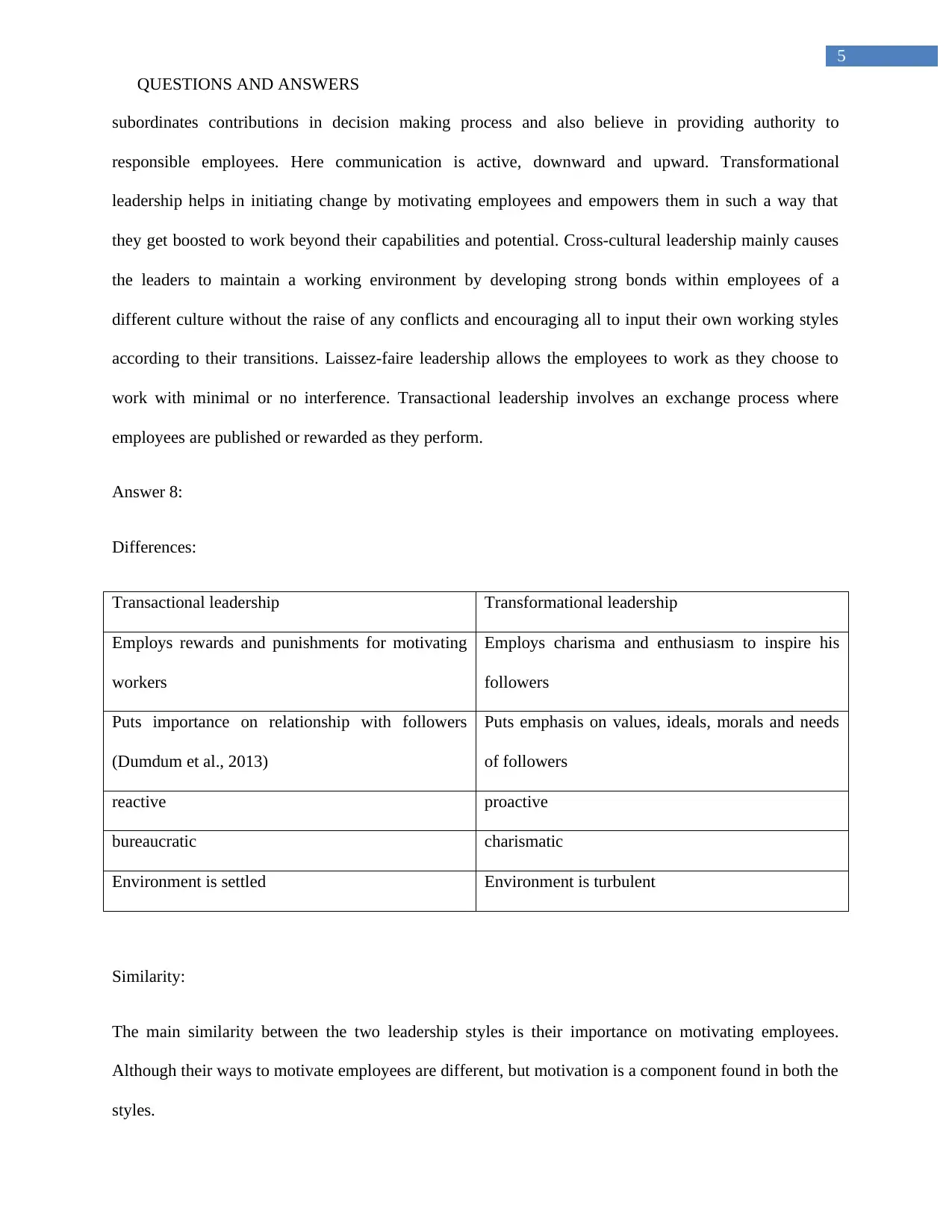
5
QUESTIONS AND ANSWERS
subordinates contributions in decision making process and also believe in providing authority to
responsible employees. Here communication is active, downward and upward. Transformational
leadership helps in initiating change by motivating employees and empowers them in such a way that
they get boosted to work beyond their capabilities and potential. Cross-cultural leadership mainly causes
the leaders to maintain a working environment by developing strong bonds within employees of a
different culture without the raise of any conflicts and encouraging all to input their own working styles
according to their transitions. Laissez-faire leadership allows the employees to work as they choose to
work with minimal or no interference. Transactional leadership involves an exchange process where
employees are published or rewarded as they perform.
Answer 8:
Differences:
Transactional leadership Transformational leadership
Employs rewards and punishments for motivating
workers
Employs charisma and enthusiasm to inspire his
followers
Puts importance on relationship with followers
(Dumdum et al., 2013)
Puts emphasis on values, ideals, morals and needs
of followers
reactive proactive
bureaucratic charismatic
Environment is settled Environment is turbulent
Similarity:
The main similarity between the two leadership styles is their importance on motivating employees.
Although their ways to motivate employees are different, but motivation is a component found in both the
styles.
QUESTIONS AND ANSWERS
subordinates contributions in decision making process and also believe in providing authority to
responsible employees. Here communication is active, downward and upward. Transformational
leadership helps in initiating change by motivating employees and empowers them in such a way that
they get boosted to work beyond their capabilities and potential. Cross-cultural leadership mainly causes
the leaders to maintain a working environment by developing strong bonds within employees of a
different culture without the raise of any conflicts and encouraging all to input their own working styles
according to their transitions. Laissez-faire leadership allows the employees to work as they choose to
work with minimal or no interference. Transactional leadership involves an exchange process where
employees are published or rewarded as they perform.
Answer 8:
Differences:
Transactional leadership Transformational leadership
Employs rewards and punishments for motivating
workers
Employs charisma and enthusiasm to inspire his
followers
Puts importance on relationship with followers
(Dumdum et al., 2013)
Puts emphasis on values, ideals, morals and needs
of followers
reactive proactive
bureaucratic charismatic
Environment is settled Environment is turbulent
Similarity:
The main similarity between the two leadership styles is their importance on motivating employees.
Although their ways to motivate employees are different, but motivation is a component found in both the
styles.
⊘ This is a preview!⊘
Do you want full access?
Subscribe today to unlock all pages.

Trusted by 1+ million students worldwide
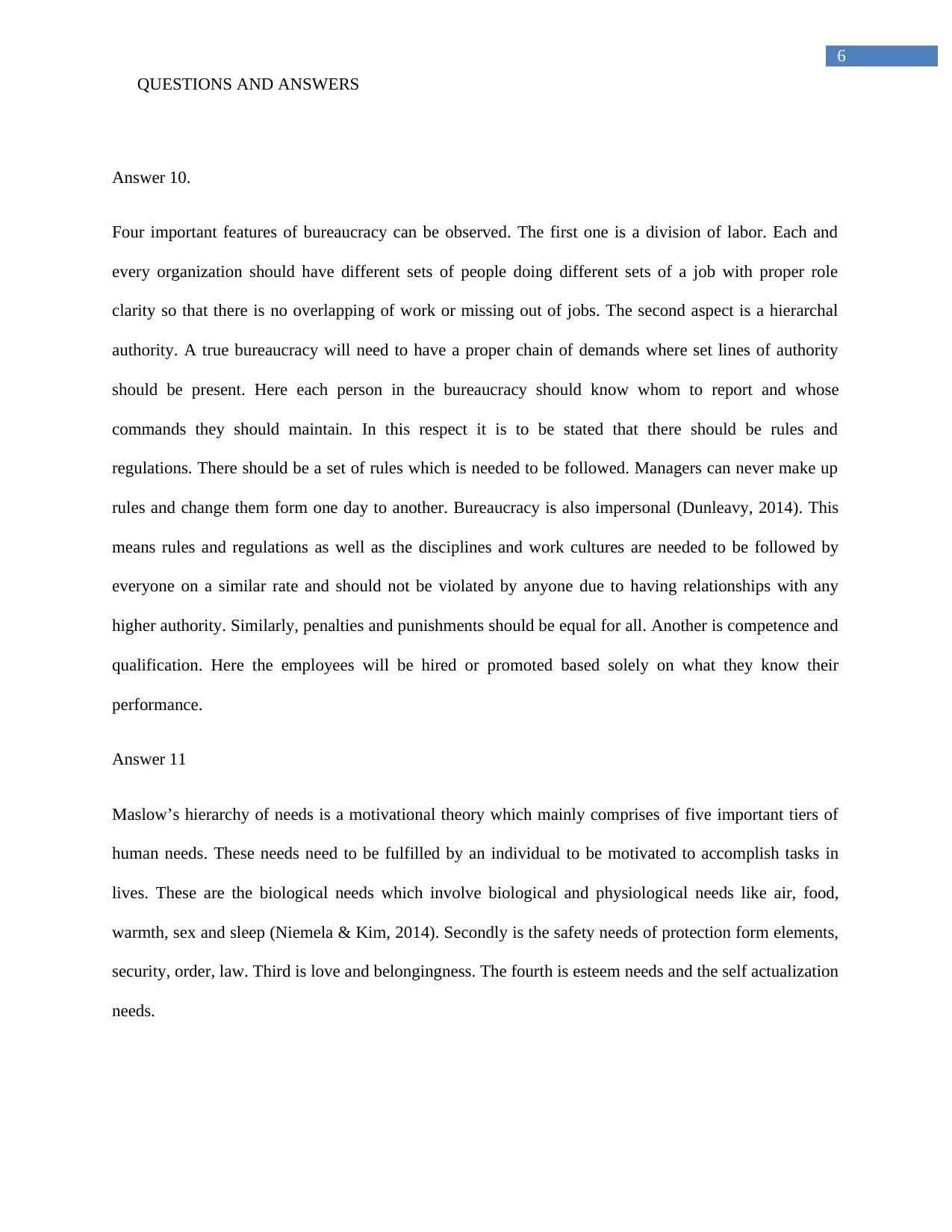
6
QUESTIONS AND ANSWERS
Answer 10.
Four important features of bureaucracy can be observed. The first one is a division of labor. Each and
every organization should have different sets of people doing different sets of a job with proper role
clarity so that there is no overlapping of work or missing out of jobs. The second aspect is a hierarchal
authority. A true bureaucracy will need to have a proper chain of demands where set lines of authority
should be present. Here each person in the bureaucracy should know whom to report and whose
commands they should maintain. In this respect it is to be stated that there should be rules and
regulations. There should be a set of rules which is needed to be followed. Managers can never make up
rules and change them form one day to another. Bureaucracy is also impersonal (Dunleavy, 2014). This
means rules and regulations as well as the disciplines and work cultures are needed to be followed by
everyone on a similar rate and should not be violated by anyone due to having relationships with any
higher authority. Similarly, penalties and punishments should be equal for all. Another is competence and
qualification. Here the employees will be hired or promoted based solely on what they know their
performance.
Answer 11
Maslow’s hierarchy of needs is a motivational theory which mainly comprises of five important tiers of
human needs. These needs need to be fulfilled by an individual to be motivated to accomplish tasks in
lives. These are the biological needs which involve biological and physiological needs like air, food,
warmth, sex and sleep (Niemela & Kim, 2014). Secondly is the safety needs of protection form elements,
security, order, law. Third is love and belongingness. The fourth is esteem needs and the self actualization
needs.
QUESTIONS AND ANSWERS
Answer 10.
Four important features of bureaucracy can be observed. The first one is a division of labor. Each and
every organization should have different sets of people doing different sets of a job with proper role
clarity so that there is no overlapping of work or missing out of jobs. The second aspect is a hierarchal
authority. A true bureaucracy will need to have a proper chain of demands where set lines of authority
should be present. Here each person in the bureaucracy should know whom to report and whose
commands they should maintain. In this respect it is to be stated that there should be rules and
regulations. There should be a set of rules which is needed to be followed. Managers can never make up
rules and change them form one day to another. Bureaucracy is also impersonal (Dunleavy, 2014). This
means rules and regulations as well as the disciplines and work cultures are needed to be followed by
everyone on a similar rate and should not be violated by anyone due to having relationships with any
higher authority. Similarly, penalties and punishments should be equal for all. Another is competence and
qualification. Here the employees will be hired or promoted based solely on what they know their
performance.
Answer 11
Maslow’s hierarchy of needs is a motivational theory which mainly comprises of five important tiers of
human needs. These needs need to be fulfilled by an individual to be motivated to accomplish tasks in
lives. These are the biological needs which involve biological and physiological needs like air, food,
warmth, sex and sleep (Niemela & Kim, 2014). Secondly is the safety needs of protection form elements,
security, order, law. Third is love and belongingness. The fourth is esteem needs and the self actualization
needs.
Paraphrase This Document
Need a fresh take? Get an instant paraphrase of this document with our AI Paraphraser
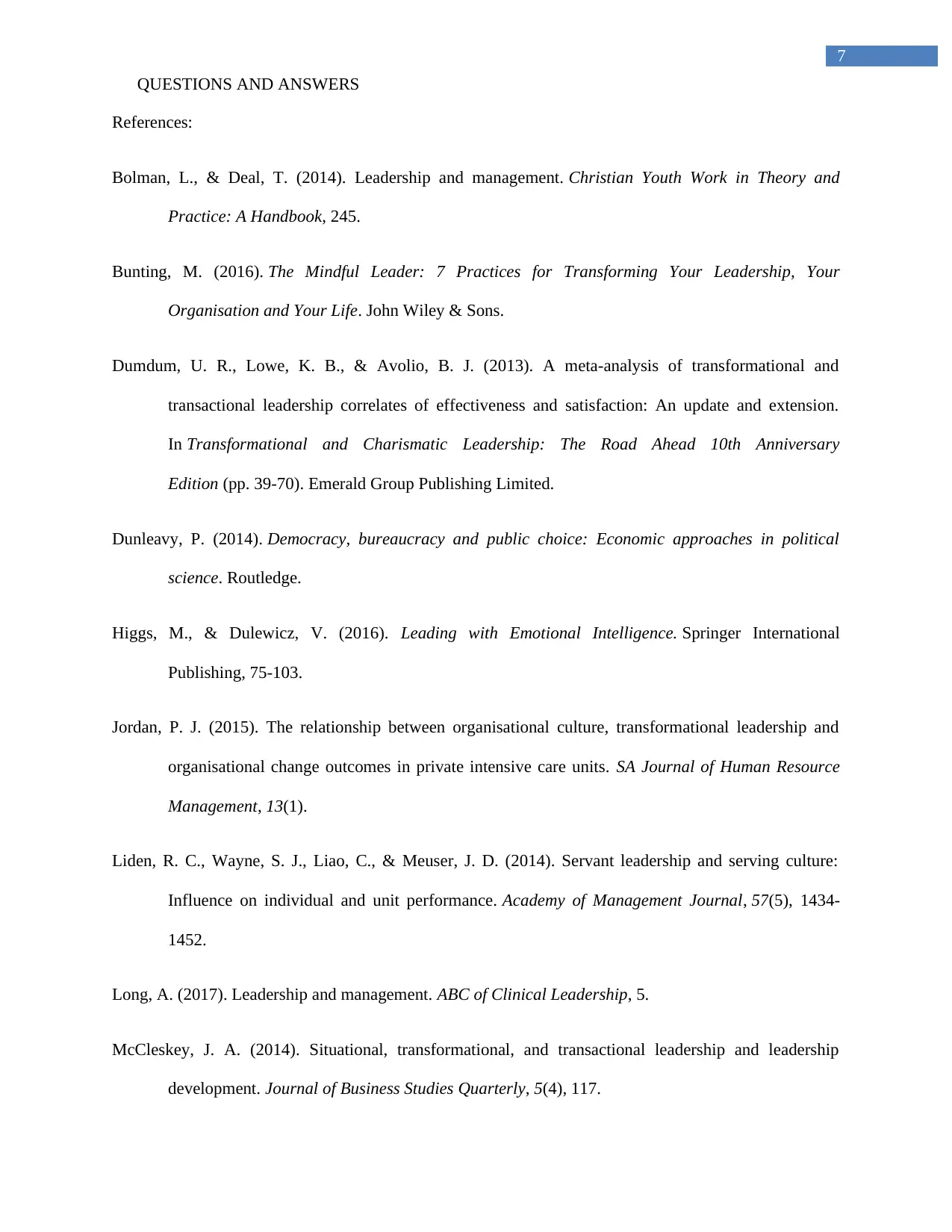
7
QUESTIONS AND ANSWERS
References:
Bolman, L., & Deal, T. (2014). Leadership and management. Christian Youth Work in Theory and
Practice: A Handbook, 245.
Bunting, M. (2016). The Mindful Leader: 7 Practices for Transforming Your Leadership, Your
Organisation and Your Life. John Wiley & Sons.
Dumdum, U. R., Lowe, K. B., & Avolio, B. J. (2013). A meta-analysis of transformational and
transactional leadership correlates of effectiveness and satisfaction: An update and extension.
In Transformational and Charismatic Leadership: The Road Ahead 10th Anniversary
Edition (pp. 39-70). Emerald Group Publishing Limited.
Dunleavy, P. (2014). Democracy, bureaucracy and public choice: Economic approaches in political
science. Routledge.
Higgs, M., & Dulewicz, V. (2016). Leading with Emotional Intelligence. Springer International
Publishing, 75-103.
Jordan, P. J. (2015). The relationship between organisational culture, transformational leadership and
organisational change outcomes in private intensive care units. SA Journal of Human Resource
Management, 13(1).
Liden, R. C., Wayne, S. J., Liao, C., & Meuser, J. D. (2014). Servant leadership and serving culture:
Influence on individual and unit performance. Academy of Management Journal, 57(5), 1434-
1452.
Long, A. (2017). Leadership and management. ABC of Clinical Leadership, 5.
McCleskey, J. A. (2014). Situational, transformational, and transactional leadership and leadership
development. Journal of Business Studies Quarterly, 5(4), 117.
QUESTIONS AND ANSWERS
References:
Bolman, L., & Deal, T. (2014). Leadership and management. Christian Youth Work in Theory and
Practice: A Handbook, 245.
Bunting, M. (2016). The Mindful Leader: 7 Practices for Transforming Your Leadership, Your
Organisation and Your Life. John Wiley & Sons.
Dumdum, U. R., Lowe, K. B., & Avolio, B. J. (2013). A meta-analysis of transformational and
transactional leadership correlates of effectiveness and satisfaction: An update and extension.
In Transformational and Charismatic Leadership: The Road Ahead 10th Anniversary
Edition (pp. 39-70). Emerald Group Publishing Limited.
Dunleavy, P. (2014). Democracy, bureaucracy and public choice: Economic approaches in political
science. Routledge.
Higgs, M., & Dulewicz, V. (2016). Leading with Emotional Intelligence. Springer International
Publishing, 75-103.
Jordan, P. J. (2015). The relationship between organisational culture, transformational leadership and
organisational change outcomes in private intensive care units. SA Journal of Human Resource
Management, 13(1).
Liden, R. C., Wayne, S. J., Liao, C., & Meuser, J. D. (2014). Servant leadership and serving culture:
Influence on individual and unit performance. Academy of Management Journal, 57(5), 1434-
1452.
Long, A. (2017). Leadership and management. ABC of Clinical Leadership, 5.
McCleskey, J. A. (2014). Situational, transformational, and transactional leadership and leadership
development. Journal of Business Studies Quarterly, 5(4), 117.
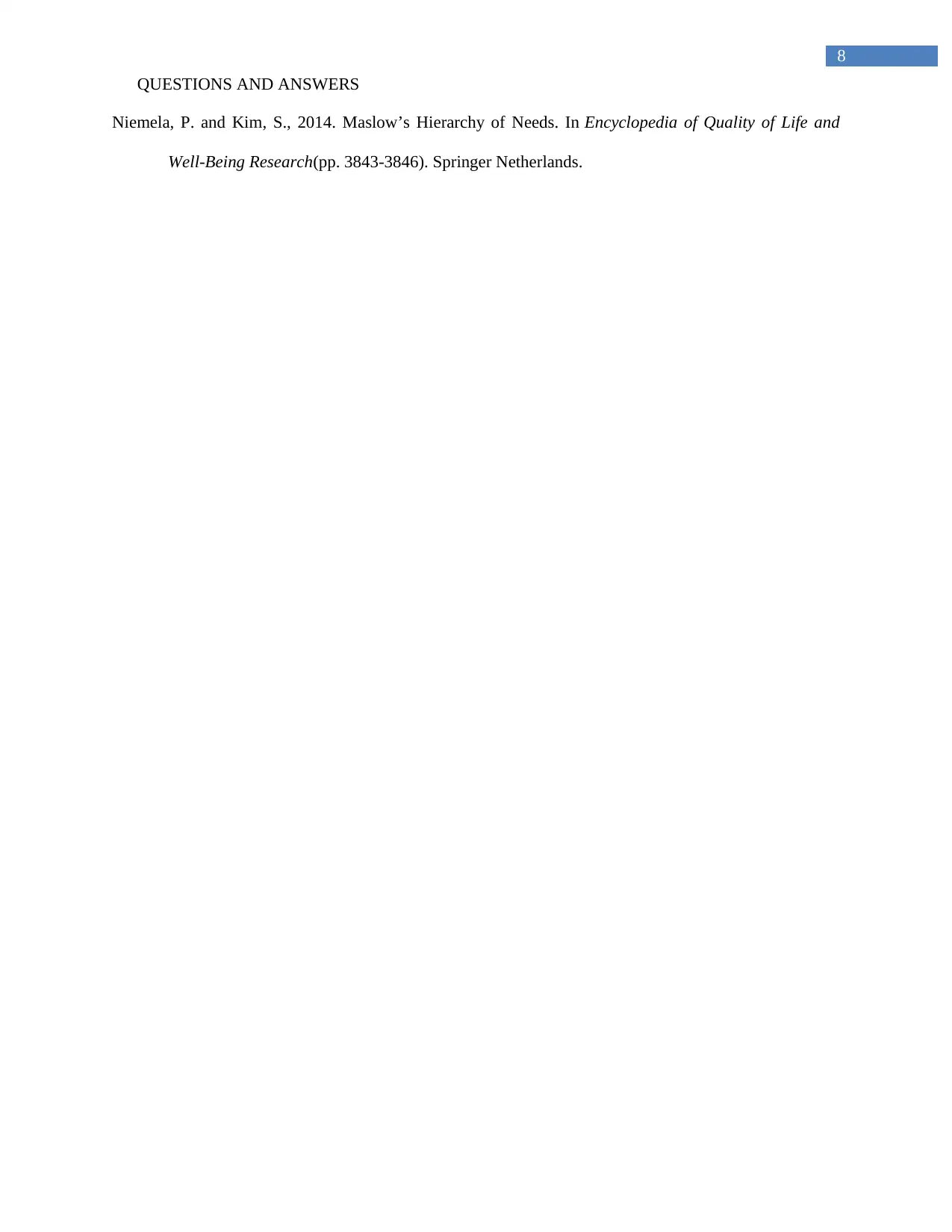
8
QUESTIONS AND ANSWERS
Niemela, P. and Kim, S., 2014. Maslow’s Hierarchy of Needs. In Encyclopedia of Quality of Life and
Well-Being Research(pp. 3843-3846). Springer Netherlands.
QUESTIONS AND ANSWERS
Niemela, P. and Kim, S., 2014. Maslow’s Hierarchy of Needs. In Encyclopedia of Quality of Life and
Well-Being Research(pp. 3843-3846). Springer Netherlands.
⊘ This is a preview!⊘
Do you want full access?
Subscribe today to unlock all pages.

Trusted by 1+ million students worldwide
1 out of 9
Related Documents
Your All-in-One AI-Powered Toolkit for Academic Success.
+13062052269
info@desklib.com
Available 24*7 on WhatsApp / Email
![[object Object]](/_next/static/media/star-bottom.7253800d.svg)
Unlock your academic potential
Copyright © 2020–2025 A2Z Services. All Rights Reserved. Developed and managed by ZUCOL.





